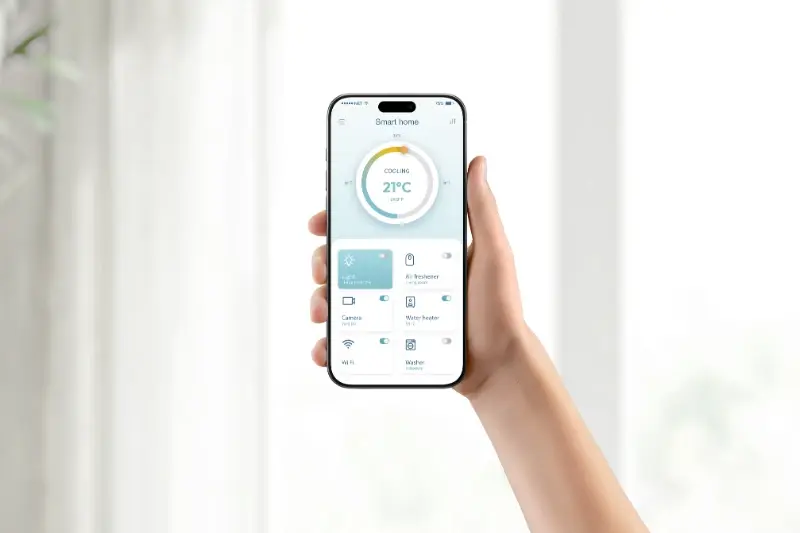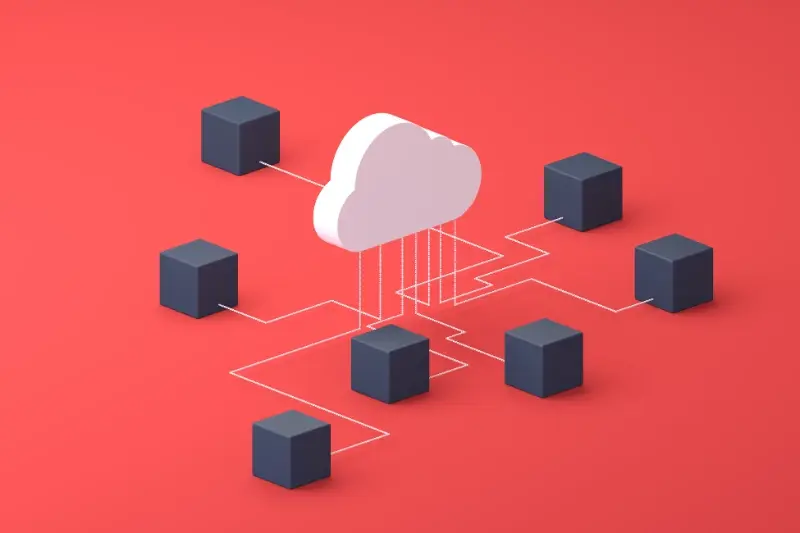The Complete Guide to IoT Integration in Mobile Apps
Over 75 billion connected devices will be communicating with mobile apps by 2030—that's roughly 10 smart gadgets for every person on Earth. If you've ever used your phone to check your smart doorbell, adjust your thermostat, or track your fitness watch, you've already experienced IoT integration in action. The Internet of Things isn't some futuristic concept anymore; it's here, and it's changing how we interact with technology every single day.
Mobile apps have become the command centre for our connected lives. Your smartphone talks to your smart home, your car, your watch, even your coffee machine. But here's what most people don't realise—building these connections properly requires careful planning, solid technical foundations, and a deep understanding of how humans actually want to interact with smart technology.
The magic happens when your mobile app becomes invisible, and controlling your connected world feels as natural as turning on a light switch.
At Glance, we've spent years helping businesses navigate this connected landscape. We've seen apps that make IoT integration look effortless, and we've seen others that overcomplicate everything. The difference usually comes down to understanding the fundamentals—not just the technical bits (though they matter), but the human side too. How do you design experiences that work seamlessly with connected devices? How do you keep everything secure? How do you plan an integration strategy that won't leave you pulling your hair out six months down the line? That's exactly what we'll cover in this guide.
What Is IoT And Why Does It Matter For Mobile Apps
IoT stands for Internet of Things, and before your eyes glaze over thinking this is some complicated tech jargon—it's actually quite simple. IoT is just a fancy way of describing everyday objects that can connect to the internet and talk to other devices. Your smart thermostat, fitness tracker, or even your coffee machine that you can control from your phone; these are all IoT devices.
Think about it this way: we've moved from having just computers and phones connected to the internet, to having almost everything around us getting smart and connected. Your doorbell can now send video to your phone when someone rings it. Your car can tell you when it needs servicing. Your washing machine can text you when your clothes are ready—though whether you actually want that notification is another question entirely!
Why Mobile Apps Need IoT Integration
Here's where it gets interesting for mobile app development. People don't want to have twenty different apps to control twenty different smart devices; they want one app that brings everything together seamlessly. That's where IoT integration becomes really valuable for app developers.
Mobile apps serve as the perfect control centre for IoT devices because we already carry our phones everywhere. Instead of walking over to adjust your heating or checking if you locked your front door, you can do it all from your mobile app whilst you're still in bed—or halfway across the world.
The Business Case for IoT Integration
From a business perspective, IoT integration opens up completely new possibilities for mobile apps. You can collect real-world data about how people use your products, offer remote monitoring services, or create apps that respond automatically to changes in the physical environment. The opportunities are genuinely endless, and we're still only scratching the surface of what's possible when mobile apps and IoT devices work together properly.
How IoT Devices Talk To Your Mobile App
Getting your mobile app to talk to connected devices isn't rocket science, but there are definitely some things you need to know. Think of it like having a conversation—your app and your smart technology need to speak the same language and use the right channels to communicate.
Most IoT devices use wireless protocols to send and receive data. Wi-Fi is the most common one you'll encounter; it's reliable and works well for devices that need to send lots of information quickly. Bluetooth is brilliant for short-range connections and uses less battery power—perfect for wearables and fitness trackers. Then there's Zigbee and Z-Wave for smart home devices, though these typically need a hub to bridge the connection to your app.
The Communication Flow
Here's how the magic happens: your connected devices collect data (temperature readings, movement sensors, whatever they're designed to monitor) and send this information to either a cloud server or directly to your mobile app. Your app then processes this data and presents it to users in a way that makes sense.
- Device collects sensor data
- Data gets packaged and transmitted via wireless protocol
- Cloud server or app receives and processes the information
- User sees meaningful results on their phone screen
- Commands can flow back from app to device
Always build in error handling for when devices go offline or lose connection—users will thank you when their smart home doesn't break every time the Wi-Fi hiccups.
Real-Time vs Batch Communication
Some devices need instant communication—like security cameras or emergency sensors. Others can wait and send data in batches to save battery life. Understanding which approach your connected devices need will shape how you build your mobile app's communication layer.
Planning Your IoT Mobile App Integration Strategy
Right, let's get down to the nitty-gritty of planning your IoT integration. I've seen too many projects fail because teams jumped straight into coding without a proper strategy—and trust me, that's a recipe for disaster. The planning phase is where you make or break your IoT mobile app project.
Start by identifying which devices you actually need to connect to. Don't just connect everything because you can; be selective. Ask yourself what value each device connection brings to your users. Understanding IoT connectivity requirements will help you make smart decisions about which devices to prioritise.
Device Compatibility and Communication Protocols
Next, you need to understand how these devices communicate. Different IoT devices use different protocols—some use WiFi, others use Bluetooth, and some use cellular connections. Each has its own quirks and limitations that'll affect your app design.
- WiFi devices: Great for data-heavy applications but need network access
- Bluetooth devices: Perfect for close-range interactions but limited range
- Cellular devices: Work anywhere but can be expensive to operate
- Zigbee or Z-Wave: Low power but need special hubs
Data Flow and User Journey Mapping
Map out exactly how data flows from device to app and back again. Where does the data get processed? How quickly does your app need to respond? Some applications need real-time responses—think security systems—whilst others can handle delays.
Consider offline scenarios too. What happens when the device loses connection? Your users won't stop using your app just because their smart thermostat can't reach the internet. Plan for these situations from the start, not as an afterthought.
Building The Technical Foundation For IoT Connectivity
Right, let's get our hands dirty with the technical bits. Building a mobile app that connects to smart devices requires careful consideration of cloud platform architecture and infrastructure that sits between your app and all those smart gadgets.
Your app needs what we call middleware; think of it as the translator that helps your mobile app understand what your smart thermostat or fitness tracker is trying to say. Most IoT projects use cloud platforms like AWS IoT Core or Google Cloud IoT because they handle the heavy lifting of device management and data processing.
Choosing Your Communication Protocol
Different smart devices speak different languages. Some use MQTT (which is great for devices that need to save battery), others use HTTP REST APIs, and some use WebSockets for real-time communication. Your mobile app needs to be ready for all of these conversations.
The biggest mistake we see developers make is trying to build everything from scratch when there are perfectly good IoT platforms that do the hard work for you
Database Design For IoT Data
Here's where things get interesting—IoT devices generate loads of data. Your database needs to handle thousands of temperature readings, movement sensors, and status updates without breaking a sweat. Time-series databases are your best friend here; they're designed to store data that changes over time.
Don't forget about offline functionality either. Your users won't be happy if they can't control their smart lights when the internet goes down. Build local caching and sync capabilities right from the start—trust me on this one.
Creating User Experiences That Work With Connected Devices
When you're designing an IoT mobile app, the biggest challenge isn't the technology—it's making sure people can actually use it without wanting to throw their phone across the room. I've seen brilliant technical integrations fall flat because nobody thought about how confusing it would be for users to control five different smart devices through one app.
The key is keeping things simple, even when the background processes are complex. Your users shouldn't need to understand how Bluetooth Low Energy works or what a REST API is; they just want their smart lights to turn on when they tap a button. This means designing interfaces that hide the technical complexity whilst giving people clear feedback about what's happening with their devices.
Making Device Status Crystal Clear
One thing that trips up many IoT apps is poor status communication. When someone opens your app, they need to know immediately which devices are online, offline, or having connection issues. Use clear visual indicators—not just tiny green dots that people might miss. Show battery levels for devices that need them, and always explain what's happening when something goes wrong.
Handling the Waiting Game
IoT devices don't always respond instantly. Sometimes there's a delay whilst your app communicates with a device through the cloud, or maybe the device is temporarily out of range. Build your interface to handle these delays gracefully—show loading states, give users realistic expectations about response times, and never leave them wondering if their command actually worked. Understanding what offline features users actually want will help you design better experiences for these inevitable connectivity gaps.
Testing And Securing Your IoT Mobile App
Testing a mobile app that connects to smart technology isn't like testing a regular app. You've got to think about what happens when your washing machine goes offline mid-cycle, or when someone's smart doorbell loses connection just as a delivery arrives. The complexity multiplies because you're not just testing one thing—you're testing how your app behaves with dozens of different connected devices, each with their own quirks.
Start with device simulation testing. This means creating fake versions of your IoT devices that can mimic real-world problems. Your app needs to handle slow responses, complete device failures, and those annoying moments when devices randomly disconnect. I always test what we call "edge cases"—the weird situations that probably won't happen but definitely will.
Security Comes First
Security in IoT apps is non-negotiable. Every connected device becomes a potential entry point for hackers, and your mobile app is the gateway they'll target first. IoT security requires multiple layers of protection—use encrypted communication between your app and devices, never send data in plain text, and ensure authentication happens at multiple levels: user login, device pairing, and ongoing session validation.
Always test your app's behaviour when devices suddenly go offline. Users get frustrated when apps crash or freeze just because their smart kettle lost WiFi connection.
Real-World Testing Scenarios
Here are the testing scenarios you can't skip:
- Multiple devices connecting and disconnecting simultaneously
- Poor internet connection affecting device communication
- Battery drain from constant device scanning
- App behaviour during operating system updates
- Data synchronisation when connection returns after outages
Remember, your users will blame your mobile app when their smart technology doesn't work properly—even if it's the device that's faulty. That's why thorough testing and bulletproof security aren't just nice-to-haves; they're what separate amateur IoT apps from professional ones that people actually trust and use daily.
Conclusion
Building an IoT-connected mobile app isn't just about adding fancy features—it's about creating something that genuinely makes people's lives easier. After working with countless clients who wanted to jump on the IoT bandwagon, I've learned that the most successful projects are the ones that solve real problems rather than just showing off what's technically possible.
The technical challenges we've covered—from setting up secure connections to handling different device protocols—might seem daunting at first. But here's the thing: every complex project starts with understanding the basics. Once you've got your head around how devices communicate with your app and what your users actually need, the rest becomes much more manageable.
Security can't be an afterthought with IoT apps. I've seen too many projects that worked beautifully in testing but fell apart when they hit the real world because security wasn't built in from day one. Your users are trusting you with their connected devices—that's not something to take lightly.
Testing is where many IoT projects stumble. You're not just testing an app; you're testing an entire ecosystem of connected devices, network conditions, and user scenarios. It takes time, patience, and a lot of coffee, but it's what separates the apps that work from the ones that frustrate users.
The IoT space moves quickly, but the principles we've discussed—planning properly, building secure foundations, focusing on user experience, and testing thoroughly—these will serve you well regardless of what new technologies emerge. Start with these fundamentals, and you'll be building IoT apps that people actually want to use.
Share this
Subscribe To Our Blog
You May Also Like
These Related Stories

Smart Home Apps: How to Connect Your App to Everything

Edge Computing vs Cloud Computing: Which Is Right for Your App?





